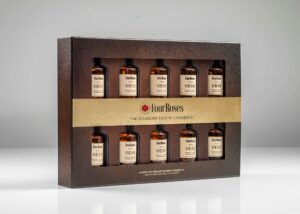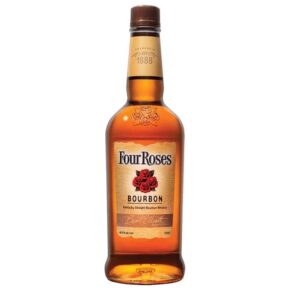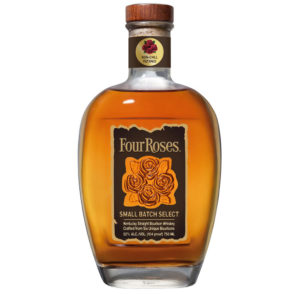Four Roses Has Ten Recipes, And Now You Can Try All Of Them

As more people are discovering the world of spirits, to the point that liquor now outperforms beer, some drinkers are looking for brands to be more forthcoming on their production methods and what exactly it is they are drinking. Enter Four Roses, a brand that most bourbon drinkers are already likely familiar with. Four Roses has virtually no secrets when it comes to it’s production methods, having offered up all the details on how it makes ten different bourbons using two different mash bills (one high rye and one low rye) and five different yeast strains. How these bourbons are blended together enables current Master Distiller Brent Elliott is able to achieve so many different variations in his releases.
Recently, Four Roses has unveiled a limited edition tasting kit, featuring all 10 of their recipes, allowing consumers to sample each individually, as well as play taking a stab (albeit one stab, what with the small amounts) at being their own blender.
Although Four Roses is a major name in bourbon nowadays, most of that recognition has come in the last 20 years, despite being founded in 1888. That would be because for much of the 20th Century, what was available in the US wasn’t their bourbon, but rather a blended whiskey, containing up to 66% neutral grain spirit. What is now the Four Roses Distillery was still making bourbon, but this was to provide stock to their parent company, mega-conglomerate, Seagram. Four Roses as an esteemed bourbon continued in Japan, where it enjoyed a good reputation. In America, it was more akin to Kentucky Gentleman.
Four Roses is currently headquartered in what was once known as the Old Prentice Distillery, purchased by Seagram in 1946. When Seagram consigned this distillery to making stock bourbon for other products, they unwittingly laid the foundation for Four Roses as we know it today, because that is how the distillery would up with its now famous ten bourbons. This industrial practice was actually widespread in Seagram’s properties, but Four Roses is one for the few survivors. Another Seagram-era survivor whose production follows a similar model is MGP.
In 1960 Four Roses current rickhouses in Cox’s Creek, KY (not at the Lawrenceburg plant), featuring single story rickhouses, rather then the multi-storied rickhouses common in bourbon country. These shorter warehouses are great for creating more consistent products, as they lack the profound temperature gradients of the taller storage structures. This mirrored Seagram’s priority placed on making consistent stocks that could be used in products across the sprawling company.

(Credit: Four Roses)
Although Four Roses bourbon may have been impossible to acquire stateside during this time, that didn’t stop them from creating some stellar bourbons under other labels. Under the direction of Master Distiller Charles L. Beam (of the storied Beam family, keeping in mind that many Beams have sought employment away from Clermont, Kentucky), the distillery released Benchmark bourbon in 1969 and Eagle Rare–yes, the same brand produced by Buffalo Trace today–in 1975.
As the other Seagram-owned distilleries in Kentucky and elsewhere closed their doors, production was slowly moved on over to the Old Prentice site, along with their yeast strains. Jim Rutledge joined the distillery in 1992, after having worked in Seagram’s corporate office in New York for some time, and quickly took over production in 1995. Over the next half decade Rutledge would appeal over and over to the corporate brass to bring Four Roses bourbon back to America, to no avail. It wasn’t until the purchase of the brand by Kirin Holdings in 2002 that Rutledge’s dream would start to take shape.
The brand’s bourbon still enjoyed a good reputation in Japan, which is what initially drew the Japanese company to Four Roses. Initially only offered in Kentucky, what was formerly known as Four Roses Yellow Label, now simply Four Roses Bourbon, was slowly introduced to more states as Kirin increased production of the product, with Rutledge introducing new expressions over time. The company has since introduced many other iterations of its bourbon, but Four Roses Bourbon continues to be the only expression drawing on all ten recipes made at the distillery. Not all ten are widely available to the drinking public: the standard Four Roses Single Barrel is recipe OBSV (high rye mash, V yeast; more on that below), with the other nine available only as private barrel bottlings. Anyone who wanted to experience each of the ten individually had to laboriously hunt these down through the various liquor stores, bars, restaurants and clubs ordering them.
Enter the new Ten Recipe Tasting Kit. Breaking into the tasting kit, one should first become familiar with how Four Roses labels their 10 whiskies. They start by naming the mash bill first with OB being their high rye mash bill and OE being the low rye mash bill. The five strains are labeled as follows: V (light and delicate fruit), K (spicy), O (bold fruitiness), Q (floral and fruity) and F (herbal). For example, OESF is their low rye mash bill and herbally yeast strain, creating a Light Oak and Mint profile (all the whiskies contain the letter S, designating it as a straight whiskey). Each sample contains 50ml of liquid and is bottled at 52% ABV. Nosing them all, their is a definite difference to every one of them. The OE (low rye) varieties smell like well-made bourbons, with the OB’s (high ryes) having a clearly defined rye characteristic. One could almost mistake them for a rye whiskey. That’s how forward the rye profile is.
 Tasting between them is not as dramatic as nosing them, but there is still a noticeable difference. The OB whiskies start to taste more like a spicy bourbon, with the corn making itself known. The OE whiskies are creamier, filling the mouth with a nice viscous feel. The strains seem to start off leaning more into bourbon notes, starting with V, and moving slowly over into more rye qualities, going to K, O, Q and ending on F. All of them seem extremely well made, although I couldn’t stand the OBSF (delicate rye and mint). It seems too astringent and herbal with not much of a sweet component.
Tasting between them is not as dramatic as nosing them, but there is still a noticeable difference. The OB whiskies start to taste more like a spicy bourbon, with the corn making itself known. The OE whiskies are creamier, filling the mouth with a nice viscous feel. The strains seem to start off leaning more into bourbon notes, starting with V, and moving slowly over into more rye qualities, going to K, O, Q and ending on F. All of them seem extremely well made, although I couldn’t stand the OBSF (delicate rye and mint). It seems too astringent and herbal with not much of a sweet component.
We’ve addressed Yellow Label drawing on all ten, but Small Batch uses just four: OBSK, OBSO, OESK and OBSO. Small Batch Select uses seven: OBSV, OBSK, OBSF, OESV, OESK and OESF. It seems to be that when Elliott is creating his blends he is going for a similar top end, with the different strains being used to increase or decrease the intensity of the rye spiciness, as well as the mouth feel. Four Roses doesn’t release the percentage of each whiskey for it’s releases, but one can still get an approximation of the blends by going off which whiskies are listed for each.
The kit seems to be a fun way to pass the evening with whiskey loving friends. Grab one of these and a couple different bottles of Four Roses, and see who can create a blend that’s closest to the official release. The winner gets to drink their blend, savoring in the delight that is Four Roses. Maybe someone is looking to create their own infinity bottle, but doesn’t know where to start. This kit would be a great crash course on how different whiskies play together, enabling someone to get their head around the concept



